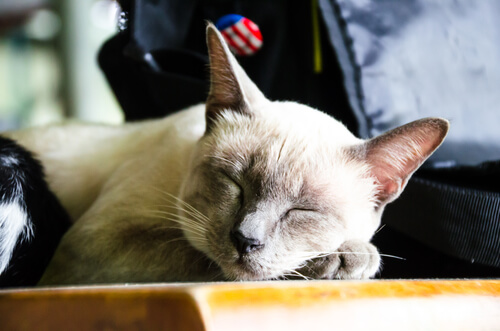How to Train Your Cat to Sleep in its Own Bed

Cats are known to be far more independent than their canine counterparts. When it comes to bedtime, however, they have a habit of sticking to us like glue. They want to lie next to you on the sofa during the day, and curl up in your bed at night. Because they are smaller and lighter than most dogs, this is usually far less inconvenient than it could be, but even so, you might prefer it if they slept in their own beds.
So, can you actually train your cat to sleep in its own bed? People generally think that cats, with their general indifference towards us humans, are much more difficult to train to follow commands. That might well be true. But just because it’s more difficult, that doesn’t make it impossible.
In this article, we’ll give you some advice on how to do it.
Why don’t cats sleep in their own beds?

Cats can sleep around 15 hours a day, so it’s not uncommon for them to change from one sleeping place to another. If you’ve ever been ill and had to spend hours or even days confined to your bed, you probably found that it quickly felt as hard as a rock, and made you ache all over.
Would you have changed place if you could have found somewhere as comfortable as your bed? Of course you would have! Well, the same thing applies to cats. While they might not be ill, sleep is an important part of their daily lives. Always sleeping in the same spot can be dull, boring and even plain annoying.
Sometimes, it might be that your cat doesn’t like its bed, but this isn’t necessarily why it won’t sleep in it. Cats look for warm, comfortable and safe spots to sleep in. To them, this generally means somewhere high off the ground, as their instinct tells them they’ll be safer there from predators.
If your cat likes to sleep in your bed, this could be for a number of reasons:
- Your cat is looking for your protection, and feels safer in your bed.
- You are part of its pack, and sleeping close to you makes sense.
- It prefers somewhere off the ground, like your bed.
- It wants to share your body heat.
- Your cat misses you. This is especially common if you spend a lot of time out of the house.
If you don’t mind your cat sleeping with you, then no problem! But if you prefer him to sleep in his own bed at night, then take a look at the following advice.
How to get your cat to sleep in its own bed
There are several things you need to do to get your cat to sleep in its own bed:
Choose the right bed
As we’ve already mentioned, one of the reasons why your cat might not sleep in its own bed is because it might not actually like it. Choosing the right bed is essential if you want this to work. So, what are the most important aspects to keep in mind?
- Size: your cat needs to fit comfortably inside its bed whether curled up or stretched out. This will help it feel safe.
- Cleaning: choose a bed that’s easy to clean. If you let lots of fur, bacteria and bad smells build up, it’ll be difficult for your cat to feel comfortable.
- Material: some beds are made of plastic, which isn’t pleasant to the touch. Others are too cold in the winter, and too warm in the summer. The best thing to do is to take your cat with you when you buy its bed, and let it try them out. It’ll have no problem letting you know which it likes best.
- Shape: you can find pet beds of all different shapes. If you know your pet well, it shouldn’t be difficult to choose. For example, if you know that your cat likes to snuggle down in a pile of cushions, choosing one with lots of cushions is ideal. It might also be a good idea to choose one that you can place up off the ground, to create a more inviting spot for your cat.
Further advice

If simply buying a good bed doesn’t do the trick, you can also try the following ideas:
- Choose a fixed place for your cat’s bed.
- If they like to be up high, buy a bed with a stand, or one that you can place off the ground.
- Tire your cat out when it’s awake during the day. That way, when it comes to bedtime, it’ll go to sleep and won’t want to move.
- Close your bedroom door at night.
- Leave a piece of your clothing in its bed. It will smell like you, and make him feel close to you.
- Leave treats in its bed so that your cat associates it with something positive.
- Make sure to praise your cat when it goes to its bed by itself.
If you do all this, with a bit of patience and perseverance, you’ll soon get your cat sleeping in its own bed.
This text is provided for informational purposes only and does not replace consultation with a professional. If in doubt, consult your specialist.